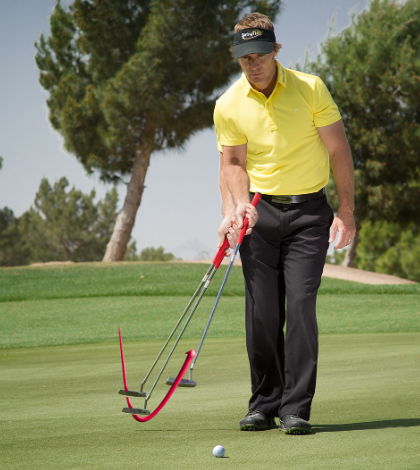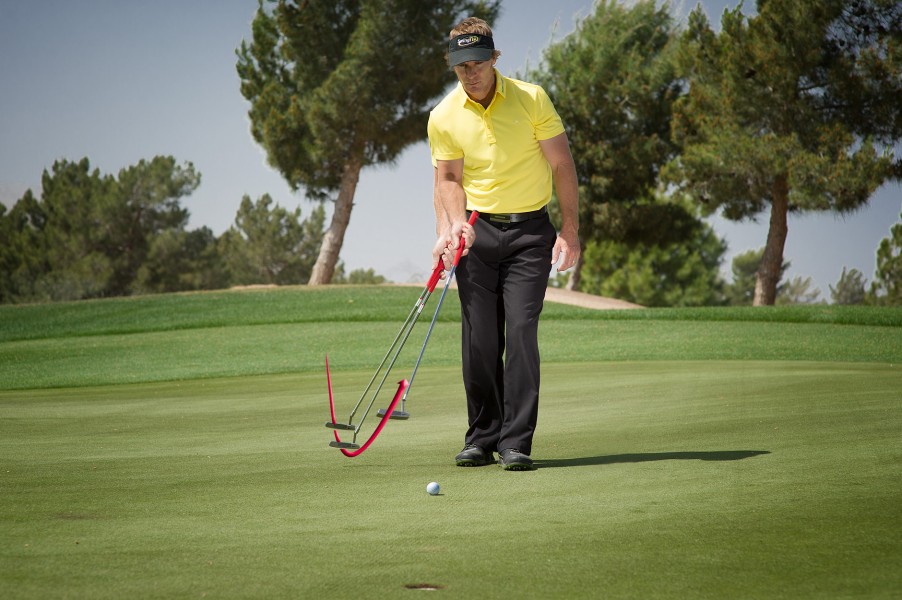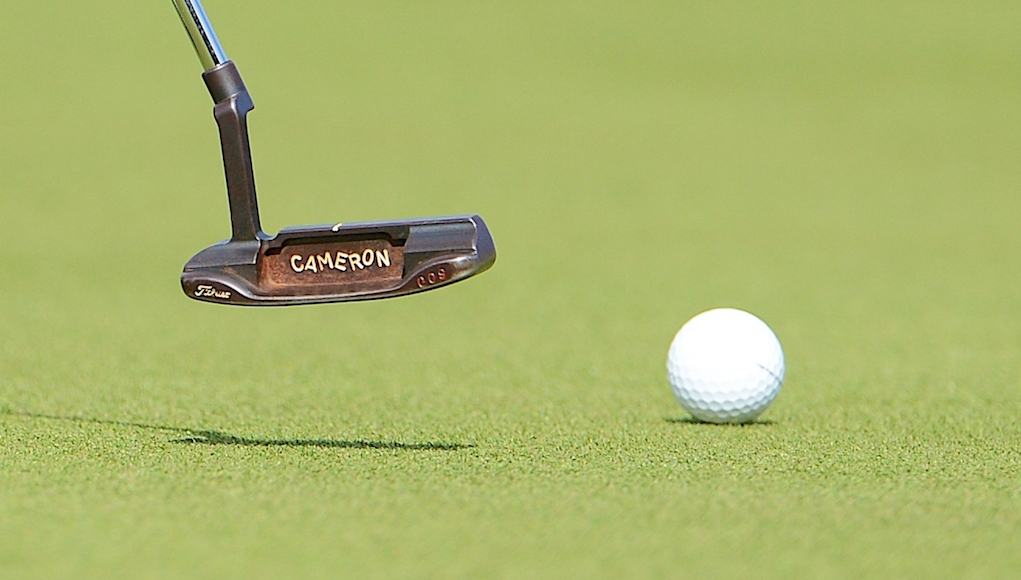Instruction
3 Steps To Lights Out Putting

Early in my coaching career I was obsessed with putting. I was in an environment where I was around a bunch of great players and it became my goal to become the model of putting proficiency. I wanted to be that example to follow and be known as a great putter to other players, as well as my peers.
To tackle my goal, I practiced like crazy. I used every training aid on the market and was consumed with building the perfect-looking stroke. After a couple years of grinding away, my putting officially reached its absolute low point.
“How could this happen?” I thought. I was a great putter as a kid. That’s partially what gave me the confidence to think that I could really be one of the best. I’d figured if I could increase my attention to detail that I’d really be able to take my putting to the next level. In the end, it was my mechanical mindset that literally became my undoing. I was so concerned with “how to stroke” that I lost all connection with the hole and the idea of getting excited about making putts.
To find my putting groove again, I had to learn to let go and focus more on the challenge associated with getting the ball into the bottom of the hole. I had to use my imagination, get into the feeling of making the ball roll, and enjoying the process of being more artist than engineer.
Putting is an area of the game than can be both complex and very simple. Certainly there are times where tuning your mechanics will help elevate your game. However, If you find yourself stuck in a rut and your goal is to simplify your approach, then this story is for you.
Take A Walk
Your first step toward “moss mastery” is learning how to view the hole from different perspectives. You see this a lot with a player like Phil Michelson, who commonly stalks his putt from a variety of angles.
In putting, what you see isn’t always what you get. Very often a putt may look relatively benign when crouched behind the ball in a traditional green reading position, however, once you walk up to the hole you get an entirely different story.
I like to begin by taking a moment to stand right by the hole. I often imagine water coming out of the cup and flowing downhill. This provides the first indication of what kind of putt I’m dealing with.
Once I know which way is downhill, I’ll circle back to the ball’s resting point and take a walk from the ball to the hole. Sometimes I’ll walk low and other times I’ll walk high. Each putt is different. If you walk high, make sure you have a good feeling as to how much break you might be playing, as a walk that’s too low could actually have you damaging your line.
As you survey the landscape really use your imagination and tap into all of your senses. Feel your balance below your feet, noticing any subtle changes in the slope. See the ball curling and diving into the cup at your ideal speed. Find your line and then commit to it. All of this can be done very quickly, so make sure you do a better job of seeing the break without making the game longer.
Find Your Flow
Once you’ve got your line nailed down, it’s time to find your flow. Let go of trying to overly control the path and face and instead focus on feeling the weight of the putter head swinging in rhythm. Try doing this from behind the ball with your eyes level to the ground, gazing down your line to the hole. Here you’re trying to feel the putt “in your gut” versus critiquing every inch of your stroke. Just like rehearsing a bean bag toss in a carnival, stare down your target and feel the putter swinging in silky smooth rhythm. In doing this, my hands are extremely soft on the club, which gives me the best opportunity to tune my senses towards getting that baby to hit rock bottom.
Keep The Feelin’
Now that you’re committed to your line and are pumped to make it, you don’t want to “lose the feeling” by taking too much time over the ball. A good rule of thumb is to putt within eight seconds of your last rehearsal swing.
With your cell phone, set your alarm to count down from eight seconds. At first, just hold the phone in your opposite hand while making rehearsals. Once you’re ready to walk into the ball, start the timer and slide the phone into your pocket. Get set over the ball, take dead aim and pull the trigger. You’ll find that the eight-second gap keeps you moving and focused, eliminating the opportunity to let mechanics and indecision disrupt your positive momentum.
Ben Crenshaw once said, “Putting is an art, not a science.” Although a little science can really help you understand a lot about the game, embracing the fun and creative side of the putting can really help you find your way again!
Instruction
The Wedge Guy: Beating the yips into submission

There may be no more painful affliction in golf than the “yips” – those uncontrollable and maddening little nervous twitches that prevent you from making a decent stroke on short putts. If you’ve never had them, consider yourself very fortunate (or possibly just very young). But I can assure you that when your most treacherous and feared golf shot is not the 195 yard approach over water with a quartering headwind…not the extra tight fairway with water left and sand right…not the soft bunker shot to a downhill pin with water on the other side…No, when your most feared shot is the remaining 2- 4-foot putt after hitting a great approach, recovery or lag putt, it makes the game almost painful.
And I’ve been fighting the yips (again) for a while now. It’s a recurring nightmare that has haunted me most of my adult life. I even had the yips when I was in my 20s, but I’ve beat them into submission off and on most of my adult life. But just recently, that nasty virus came to life once again. My lag putting has been very good, but when I get over one of those “you should make this” length putts, the entire nervous system seems to go haywire. I make great practice strokes, and then the most pitiful short-stroke or jab at the ball you can imagine. Sheesh.
But I’m a traditionalist, and do not look toward the long putter, belly putter, cross-hand, claw or other variation as the solution. My approach is to beat those damn yips into submission some other way. Here’s what I’m doing that is working pretty well, and I offer it to all of you who might have a similar affliction on the greens.
When you are over a short putt, forget the practice strokes…you want your natural eye-hand coordination to be unhindered by mechanics. Address your putt and take a good look at the hole, and back to the putter to ensure good alignment. Lighten your right hand grip on the putter and make sure that only the fingertips are in contact with the grip, to prevent you from getting to tight.
Then, take a long, long look at the hole to fill your entire mind and senses with the target. When you bring your head/eyes back to the ball, try to make a smooth, immediate move right into your backstroke — not even a second pause — and then let your hands and putter track right back together right back to where you were looking — the HOLE! Seeing the putter make contact with the ball, preferably even the forward edge of the ball – the side near the hole.
For me, this is working, but I am asking all of you to chime in with your own “home remedies” for the most aggravating and senseless of all golf maladies. It never hurts to have more to fall back on!
Instruction
Looking for a good golf instructor? Use this checklist

Over the last couple of decades, golf has become much more science-based. We measure swing speed, smash factor, angle of attack, strokes gained, and many other metrics that can really help golfers improve. But I often wonder if the advancement of golf’s “hard” sciences comes at the expense of the “soft” sciences.
Take, for example, golf instruction. Good golf instruction requires understanding swing mechanics and ball flight. But let’s take that as a given for PGA instructors. The other factors that make an instructor effective can be evaluated by social science, rather than launch monitors.
If you are a recreational golfer looking for a golf instructor, here are my top three points to consider.
1. Cultural mindset
What is “cultural mindset? To social scientists, it means whether a culture of genius or a culture of learning exists. In a golf instruction context, that may mean whether the teacher communicates a message that golf ability is something innate (you either have it or you don’t), or whether golf ability is something that can be learned. You want the latter!
It may sound obvious to suggest that you find a golf instructor who thinks you can improve, but my research suggests that it isn’t a given. In a large sample study of golf instructors, I found that when it came to recreational golfers, there was a wide range of belief systems. Some instructors strongly believed recreational golfers could improve through lessons. while others strongly believed they could not. And those beliefs manifested in the instructor’s feedback given to a student and the culture created for players.
2. Coping and self-modeling can beat role-modeling
Swing analysis technology is often preloaded with swings of PGA and LPGA Tour players. The swings of elite players are intended to be used for comparative purposes with golfers taking lessons. What social science tells us is that for novice and non-expert golfers, comparing swings to tour professionals can have the opposite effect of that intended. If you fit into the novice or non-expert category of golfer, you will learn more and be more motivated to change if you see yourself making a ‘better’ swing (self-modeling) or seeing your swing compared to a similar other (a coping model). Stay away from instructors who want to compare your swing with that of a tour player.
3. Learning theory basics
It is not a sexy selling point, but learning is a process, and that process is incremental – particularly for recreational adult players. Social science helps us understand this element of golf instruction. A good instructor will take learning slowly. He or she will give you just about enough information that challenges you, but is still manageable. The artful instructor will take time to decide what that one or two learning points are before jumping in to make full-scale swing changes. If the instructor moves too fast, you will probably leave the lesson with an arm’s length of swing thoughts and not really know which to focus on.
As an instructor, I develop a priority list of changes I want to make in a player’s technique. We then patiently and gradually work through that list. Beware of instructors who give you more than you can chew.
So if you are in the market for golf instruction, I encourage you to look beyond the X’s and O’s to find the right match!
Instruction
What Lottie Woad’s stunning debut win teaches every golfer

Most pros take months, even years, to win their first tournament. Lottie Woad needed exactly four days.
The 21-year-old from Surrey shot 21-under 267 at Dundonald Links to win the ISPS Handa Women’s Scottish Open by three shots — in her very first event as a professional. She’s only the third player in LPGA history to accomplish this feat, joining Rose Zhang (2023) and Beverly Hanson (1951).
But here’s what caught my attention as a coach: Woad didn’t win through miraculous putting or bombing 300-yard drives. She won through relentless precision and unshakeable composure. After watching her performance unfold, I’m convinced every golfer — from weekend warriors to scratch players — can steal pages from her playbook.
Precision Beats Power (And It’s Not Even Close)
Forget the driving contests. Woad proved that finding greens matters more than finding distance.
What Woad did:
• Hit it straight, hit it solid, give yourself chances
• Aimed for the fat parts of greens instead of chasing pins
• Let her putting do the talking after hitting safe targets
• As she said, “Everyone was chasing me today, and managed to maintain the lead and played really nicely down the stretch and hit a lot of good shots”
Why most golfers mess this up:
• They see a pin tucked behind a bunker and grab one more club to “go right at it”
• Distance becomes more important than accuracy
• They try to be heroic instead of smart
ACTION ITEM: For your next 10 rounds, aim for the center of every green regardless of pin position. Track your greens in regulation and watch your scores drop before your swing changes.
The Putter That Stayed Cool Under Fire
Woad started the final round two shots clear and immediately applied pressure with birdies at the 2nd and 3rd holes. When South Korea’s Hyo Joo Kim mounted a charge and reached 20-under with a birdie at the 14th, Woad didn’t panic.
How she responded to pressure:
• Fired back with consecutive birdies at the 13th and 14th
• Watched Kim stumble with back-to-back bogeys
• Capped it with her fifth birdie of the day at the par-5 18th
• Stayed patient when others pressed, pressed when others cracked
What amateurs do wrong:
• Get conservative when they should be aggressive
• Try to force magic when steady play would win
• Panic when someone else makes a move
ACTION ITEM: Practice your 3-6 foot putts for 15 minutes after every range session. Woad’s putting wasn’t spectacular—it was reliable. Make the putts you should make.
Course Management 101: Play Your Game, Not the Course’s Game
Woad admitted she couldn’t see many scoreboards during the final round, but it didn’t matter. She stuck to her game plan regardless of what others were doing.
Her mental approach:
• Focused on her process, not the competition
• Drew on past pressure situations (Augusta National Women’s Amateur win)
• As she said, “That was the biggest tournament I played in at the time and was kind of my big win. So definitely felt the pressure of it more there, and I felt like all those experiences helped me with this”
Her physical execution:
• 270-yard drives (nothing flashy)
• Methodical iron play
• Steady putting
• Everything effective, nothing spectacular
ACTION ITEM: Create a yardage book for your home course. Know your distances to every pin, every hazard, every landing area. Stick to your plan no matter what your playing partners are doing.
Mental Toughness Isn’t Born, It’s Built
The most impressive part of Woad’s win? She genuinely didn’t expect it: “I definitely wasn’t expecting to win my first event as a pro, but I knew I was playing well, and I was hoping to contend.”
Her winning mindset:
• Didn’t put winning pressure on herself
• Focused on playing well and contending
• Made winning a byproduct of a good process
• Built confidence through recent experiences:
- Won the Women’s Irish Open as an amateur
- Missed a playoff by one shot at the Evian Championship
- Each experience prepared her for the next
What this means for you:
• Stop trying to shoot career rounds every time you tee up
• Focus on executing your pre-shot routine
• Commit to every shot
• Stay present in the moment
ACTION ITEM: Before each round, set process goals instead of score goals. Example: “I will take three practice swings before every shot” or “I will pick a specific target for every shot.” Let your score be the result, not the focus.
The Real Lesson
Woad collected $300,000 for her first professional victory, but the real prize was proving that fundamentals still work at golf’s highest level. She didn’t reinvent the game — she simply executed the basics better than everyone else that week.
The fundamentals that won:
• Hit more fairways
• Find more greens
• Make the putts you should make
• Stay patient under pressure
That’s something every golfer can do, regardless of handicap. Lottie Woad just showed us it’s still the winning formula.
FINAL ACTION ITEM: Pick one of the four action items above and commit to it for the next month. Master one fundamental before moving to the next. That’s how champions are built.
PGA Professional Brendon Elliott is an award-winning coach and golf writer. You can check out his writing work and learn more about him by visiting BEAGOLFER.golf and OneMoreRollGolf.com. Also, check out “The Starter” on RG.org each Monday.
Editor’s note: Brendon shares his nearly 30 years of experience in the game with GolfWRX readers through his ongoing tip series. He looks forward to providing valuable insights and advice to help golfers improve their game. Stay tuned for more Tips!
























Dr. Jeff Eger
Jun 12, 2013 at 11:00 pm
You have discovered mental golf gives you the small tight picture,lose your flow or automaticity,dissolve imagination.When you see efficiently(in all 7 visual skills and my 6 step ocular set up) then you see EZ-trust it-Feel it(intuition)-trust it and do it.The big picture lets you see slightly ahead of real time(Zen like).Please read all my wesite if you have an open mind and truly want to be an efficient putter like you were as a kid.All consistant champions are “feel Players”,that I have worked with.When you think you have lost the feel.
David
Apr 25, 2013 at 10:39 am
Nice read, Jeff. I personally find making long putts to be one of the three most enjoyable shots in the game, along with pulling the string on a pured short iron, and the feeling of a well struck long iron. I love the idea of the timer in the pocket during practice as I believe that most putts are missed before the stroke even takes place.
Sebastian Zander
Apr 18, 2013 at 2:19 am
“Let go of trying to overly control the path and face and instead focus on feeling the weight of the putter head swinging in rhythm.” — I guess controlling the path and face is what most likely makes my putts miss the hole so often. I’ll have to change my mindset and learn to commit to my line. Feeling the weight of my putter might just be the perfect thought for focussing. I will give this one a try the next time I’m on the putting green. Thanks.
– Sebastian